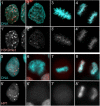Resetting a functional G1 nucleus after mitosis
- PMID: 26728621
- PMCID: PMC5023730
- DOI: 10.1007/s00412-015-0561-6
Resetting a functional G1 nucleus after mitosis
Abstract
The maintenance of the correct cellular information goes beyond the simple transmission of an intact genetic code from one generation to the next. Epigenetic changes, topological cues and correct protein-protein interactions need to be re-established after each cell division to allow the next cell cycle to resume in the correct regulated manner. This process begins with mitotic exit and re-sets all the changes that occurred during mitosis thus restoring a functional G1 nucleus in preparation for the next cell cycle. Mitotic exit is triggered by inactivation of mitotic kinases and the reversal of their phosphorylation activities on many cellular components, from nuclear lamina to transcription factors and chromatin itself. To reverse all these phosphorylations, phosphatases act during mitotic exit in a timely and spatially controlled manner directing the events that lead to a functional G1 nucleus. In this review, we will summarise the recent developments on the control of phosphatases and their known substrates during mitotic exit, and the key steps that control the restoration of chromatin status, nuclear envelope reassembly and nuclear body re-organisation. Although pivotal work has been conducted in this area in yeast, due to differences between the mitotic exit network between yeast and vertebrates, we will mainly concentrate on the vertebrate system.
Keywords: Cell division; Chromatin; Mitotic exit; Nuclear envelope; Phosphatases.
Conflict of interest statement
The authors declare that they have no competing interests. Ethical approval This article does not contain any studies with human participants or animals performed by any of the authors.
Figures



References
-
- Aagaard L, Schmid M, Warburton P, Jenuwein T. Mitotic phosphorylation of SUV39H1, a novel component of active centromeres, coincides with transient accumulation at mammalian centromeres. J Cell Sci. 2000;113(Pt 5):817–829. - PubMed
Publication types
MeSH terms
Substances
LinkOut - more resources
Full Text Sources
Other Literature Sources
Molecular Biology Databases

